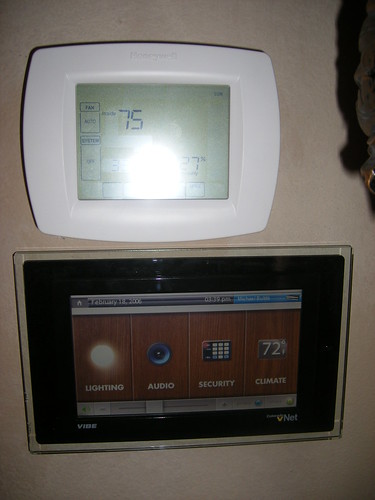I like things that are simple. So I was really disappointed after I had the opportunity to tour the New American Home and the InSync Home this past weekend here in Orlando. The homes are models that are part of the annual extravaganza that is the International Builders' Show. The New American Home was built using green principles, and the InSync Home was billed as the high-tech home of the future.
So I was really disappointed after I had the opportunity to tour the New American Home and the InSync Home this past weekend here in Orlando. The homes are models that are part of the annual extravaganza that is the International Builders' Show. The New American Home was built using green principles, and the InSync Home was billed as the high-tech home of the future.
Don't get me wrong... both are beautiful homes that represent the best that architects and builders have to offer. But when it comes to home technology, it's clear that there is still a lot of room for improvement when it comes to execution. In both homes, the basic technologies included a security system, thermostat controls, "whole home" audio, and lighting controls. (For now, I'm purposely leaving out the NAH's green technologies.)
In both homes, the basic technologies included a security system, thermostat controls, "whole home" audio, and lighting controls. (For now, I'm purposely leaving out the NAH's green technologies.)  Here's my issue: each system still has its own unique controller, sometimes for no apparent reason. This is quite apparent in the ISH, where there are touchpanels installed throughout the home that integrate all of the controls... many of these touchpanels are located right next to the security or climate control keypads.
Here's my issue: each system still has its own unique controller, sometimes for no apparent reason. This is quite apparent in the ISH, where there are touchpanels installed throughout the home that integrate all of the controls... many of these touchpanels are located right next to the security or climate control keypads.
In the NAH, there's actually one wall that has over a dozen outlets and controllers on it. Here's my favorite - the thermostat is positioned directly above the touchpanel that clearly has climate controls on the right side: If you're going to spend the money to integrate all those systems into a sleek touchpanel, doesn't it make sense to make sure your custom integrator is talking to the rest of your contractors? Here's a recent article about this from the perspective of the installers of these systems.
If you're going to spend the money to integrate all those systems into a sleek touchpanel, doesn't it make sense to make sure your custom integrator is talking to the rest of your contractors? Here's a recent article about this from the perspective of the installers of these systems.
I bring this up because this issue only gets amplified in multifamily communities. By nature, most luxury condos or apartments have a limited amount of space available. The last thing you want to do is clutter that space with every high-tech amenity that you can think of. If you're going to set yourself apart by offering advanced technologies to your buyers, make sure you have a plan for what you want to offer, and work with your designers and contractors to ensure that those technologies fit with the look of the rest of the unit's features. And remember, the simpler, the better.
Monday, February 26, 2007
Simplicity
blog comments powered by Disqus
Subscribe to:
Post Comments (Atom)


